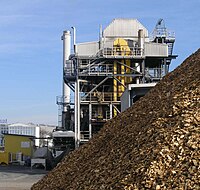Tag:plant:source=biomass
| Description |
|---|
| Biomass power plant, biogas plant |
| Group: power |
| Used on these elements |
| Requires |
| Useful combination |
| Status: approved |
| Tools for this tag |
|
In energy domains, and particularly with bioenergies, the biomass term refers to the set of organic materials originating from living, or recently living organisms (plants including algae, animals or fungus) and which can become a source of energy through combustion (e.g. wood energy), or after methanisation (e.g. biogas) or new chemical transforms (e.g. biofuel).
Plants burning solid biomass
A bio mass power plant generates electricity by burning solid bio mass. Additionally, some plants also provide heat that can be used for private housing or industrial processes. It burns solid fuels like e.g., leftovers from wood processing, forest wood that can't be used otherwise, old wood, straw.
- power=plant
- plant:source=biomass
- plant:method=combustion
- plant:output:electricity=*
- plant:output:hot_water=*
- name=*
Gas producing plants
In gas producing plants, bio mass is converted to bio gas by bio-chemical processes, such as anaerobic digestion or fermentation. Agricultural plants usually use (liquid) manure and energy plants as source material. Non-agricultural plants use bio-waste material. As a side product, the leftover digestate can be used as fertilizer. Most plants directly use the produced gas on site to produce electricity and heat in a cogenerator.
- power=plant
- plant:source=biomass
- plant:method=anaerobic_digestion
- plant:output:electricity=* - if a combined heat and power unit is integrated
- plant:output:biogas=* - if a plant for upgrading the biogas is connected
- name=*
Biogas is of biological origin. It can be made equivalent to natural gas by purification and upgrading, but it is still called biogas in the sense of OSM.
The fermenter can be mapped with building=digester.
Wood gas generator
A wood gas generator is a gasification unit which converts timber or charcoal into wood gas, a producer gas consisting of atmospheric nitrogen, carbon monoxide, hydrogen, traces of methane, and other gases, which – after cooling and filtering – can then be used to power an internal combustion engine or for other purposes.
- power=plant (obligatory)
- plant:source=biomass
- plant:method=gasification
- plant:output:biogas=*
- name=*



